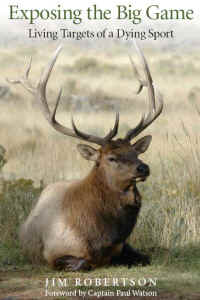
A Few Words About Game Farms
An Animal Rights Article from All-Creatures.org
FROM
Jim Robertson,
Exposing
the Big Game
February 2015
As a general rule, photographers and photo editors don’t differentiate between animals in the wild or in captivity when selling and publishing images. Photos taken at game farms set a new, unnatural standard for closeness and intimacy that the public expects to see in every future wildlife photograph. Using these shots only supports and encourages those who would profit from making their captives serve as performers for photographers, entertainers for tourists or as sitting ducks for trophy hunters.
At the end of my book [Exposing the Big Game: Living Targets of a Dying Sport] is a chapter called, “A Few Words on Ethical Wildlife Photography,” wherein I examine some of the problems that arise when over-eager photographers forget that their animal subjects have needs and interests of their own that don’t always include posing for the camera. With surprising frequency, irresponsible photo-getters are gored, trampled or charged by free-roaming animals annoyed enough to feel they must defend themselves.
But no amount of disturbance could ever equal the level of abuse and exploitation suffered by an animal stuck in a zoo or game farm. Too often, the “wild” animals seen in books or magazines are actually imprisoned specimens sentenced to life in a barren pen or cage. The only time some of these pitiable creatures see the light of day is when they’re paraded out and made to pose for a client who wants to shoot them in front of a convincingly picturesque background. Trainers at game farms have graduated from the traditional whip and chair to more technological tools, such as the electric cattle prod, to browbeat their wildlife “models” into compliance.
On the surface, many game farms seem relatively innocuous, charging only for public viewing or private photographic sessions with crowd-pleasing kittens, cubs or fawns bred specifically for that purpose. But as they get older and less photogenic, these animals are auctioned off as “surplus” to the highest bidders—a common practice of zoos as well. It’s likely the same individuals appearing as cute babies on calendars or greeting cards will end up, a few years later, getting shot—for real this time—at another fenced-in compound that allows “canned hunting.” These doubly loathsome compounds profit directly from the killing of confined, frequently exotic, species behind the high fences of their enclosures.
As a general rule, photographers and photo editors don’t differentiate between animals in the wild or in captivity when selling and publishing images. Photos taken at game farms set a new, unnatural standard for closeness and intimacy that the public expects to see in every future wildlife photograph. Using these shots only supports and encourages those who would profit from making their captives serve as performers for photographers, entertainers for tourists or as sitting ducks for trophy hunters.
_________________________________________
From my book’s copyright page: “No captives were used in the making of this book [or this blog, for that matter]. All free-roaming animals were respectfully photographed in the wild.”
See Jim's AMAZING wildlife photography here - Animals in the Wild - and BUY his book!
Return to Animal Rights Articles
Read more at Egg Production








